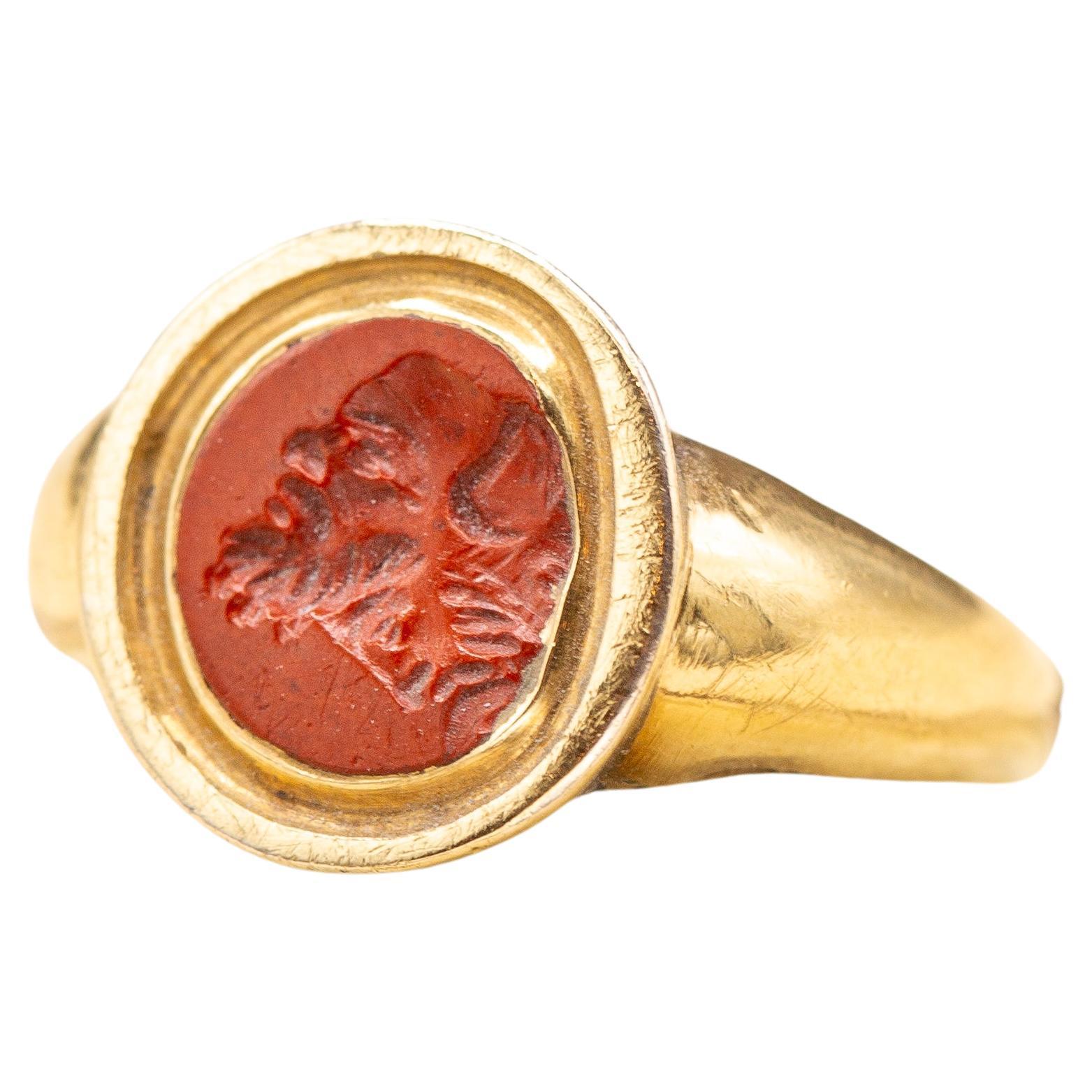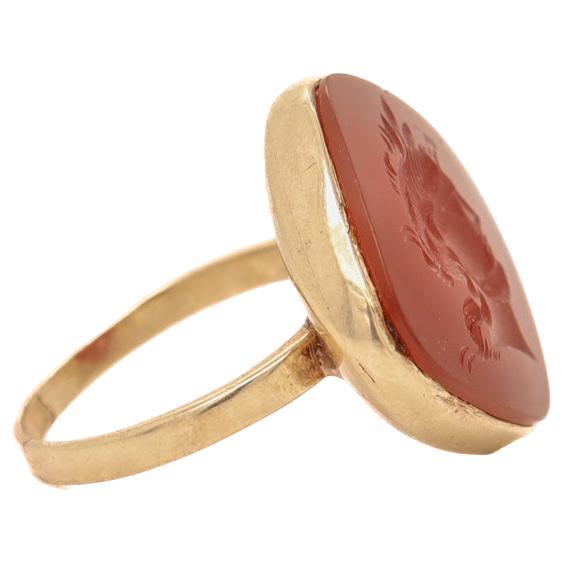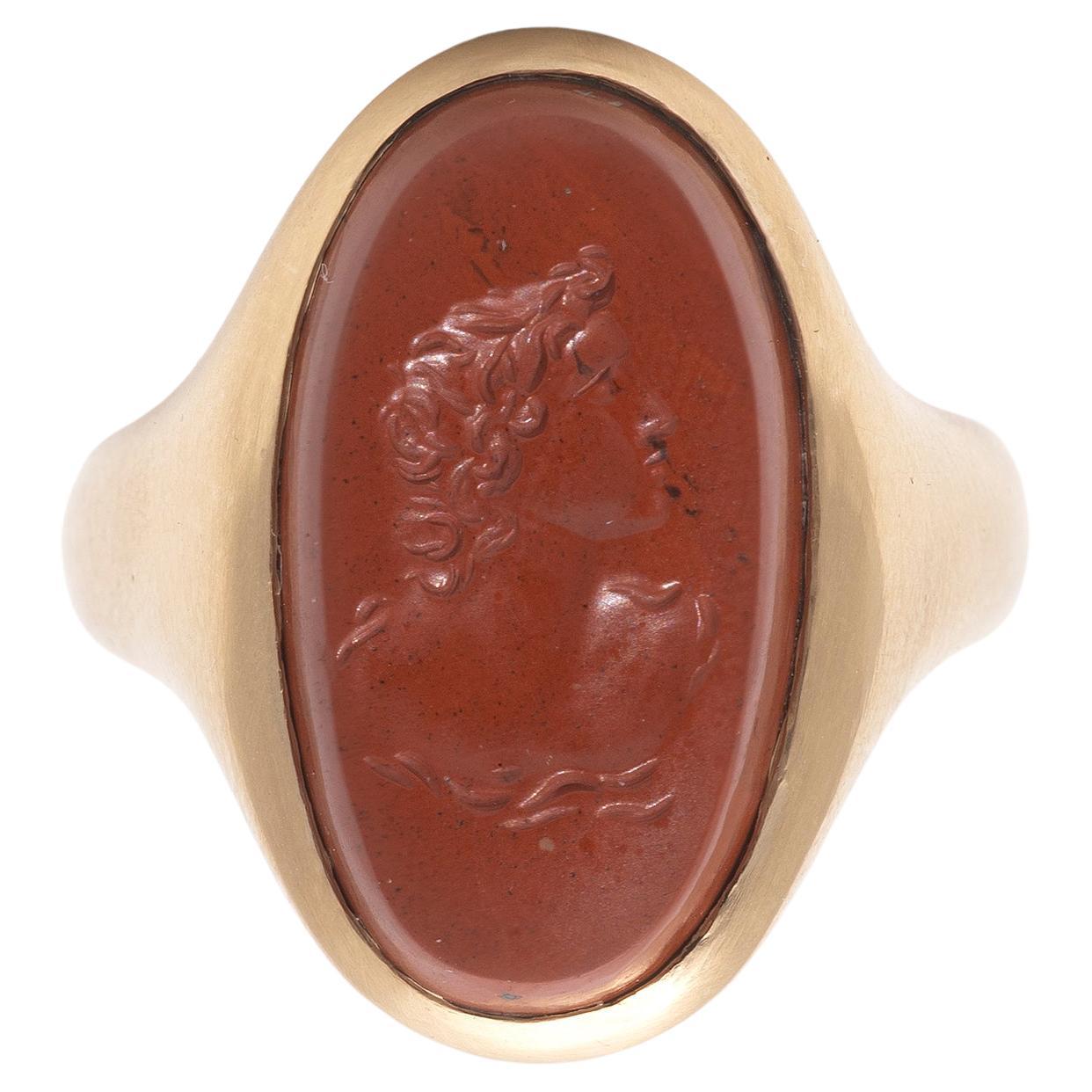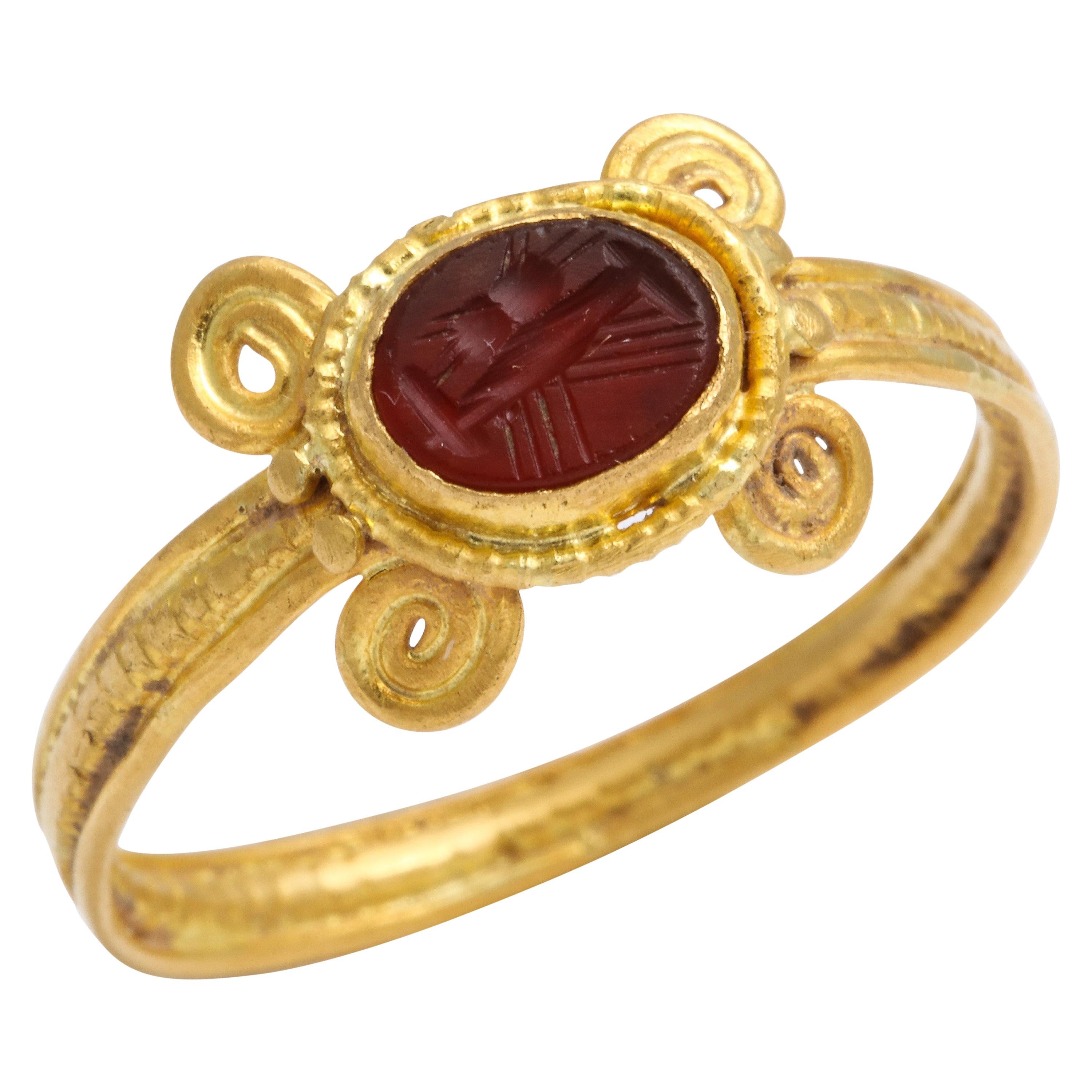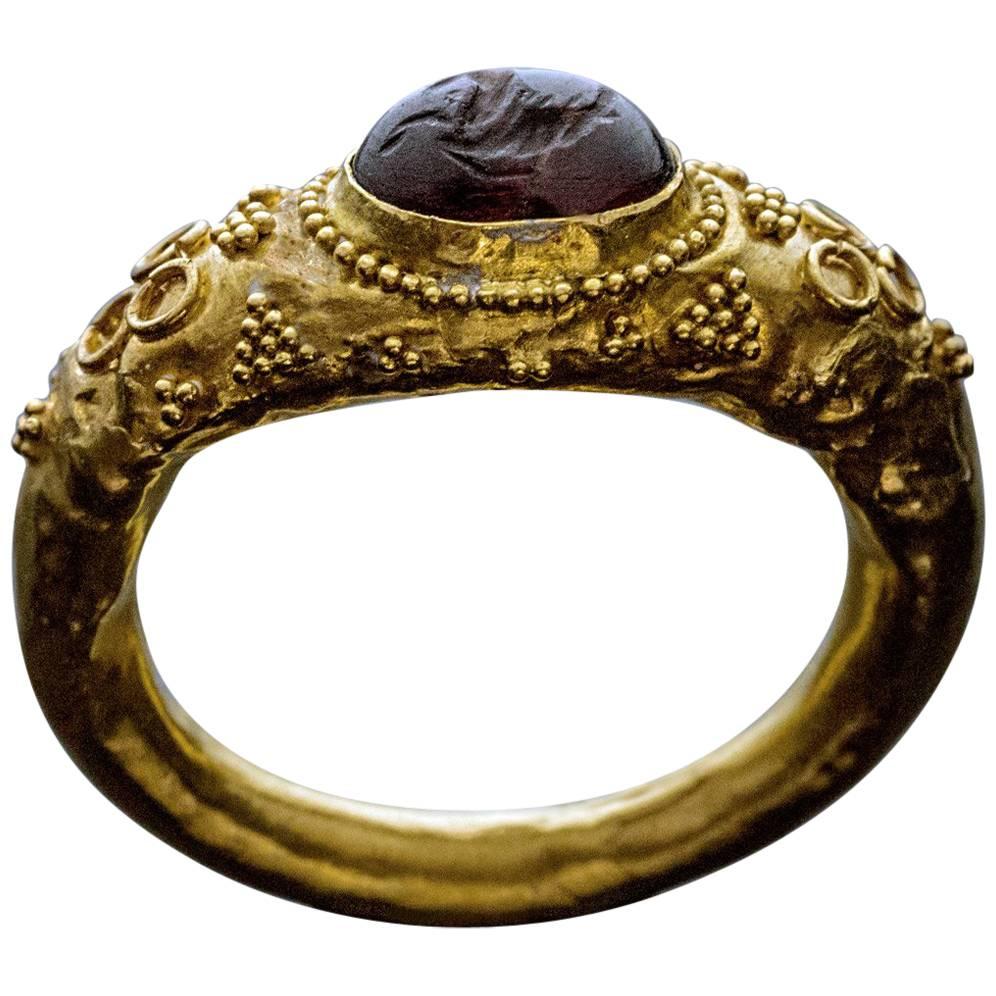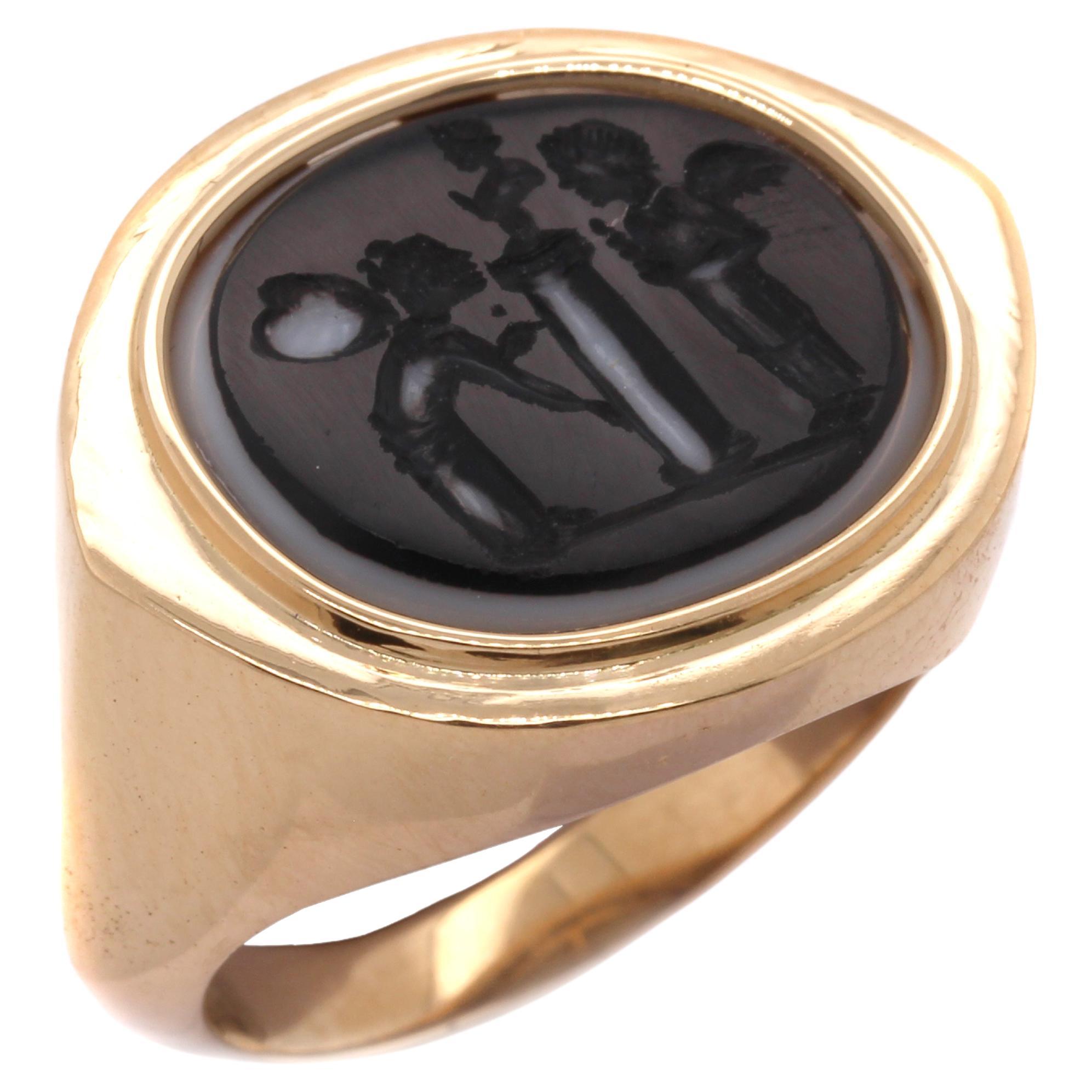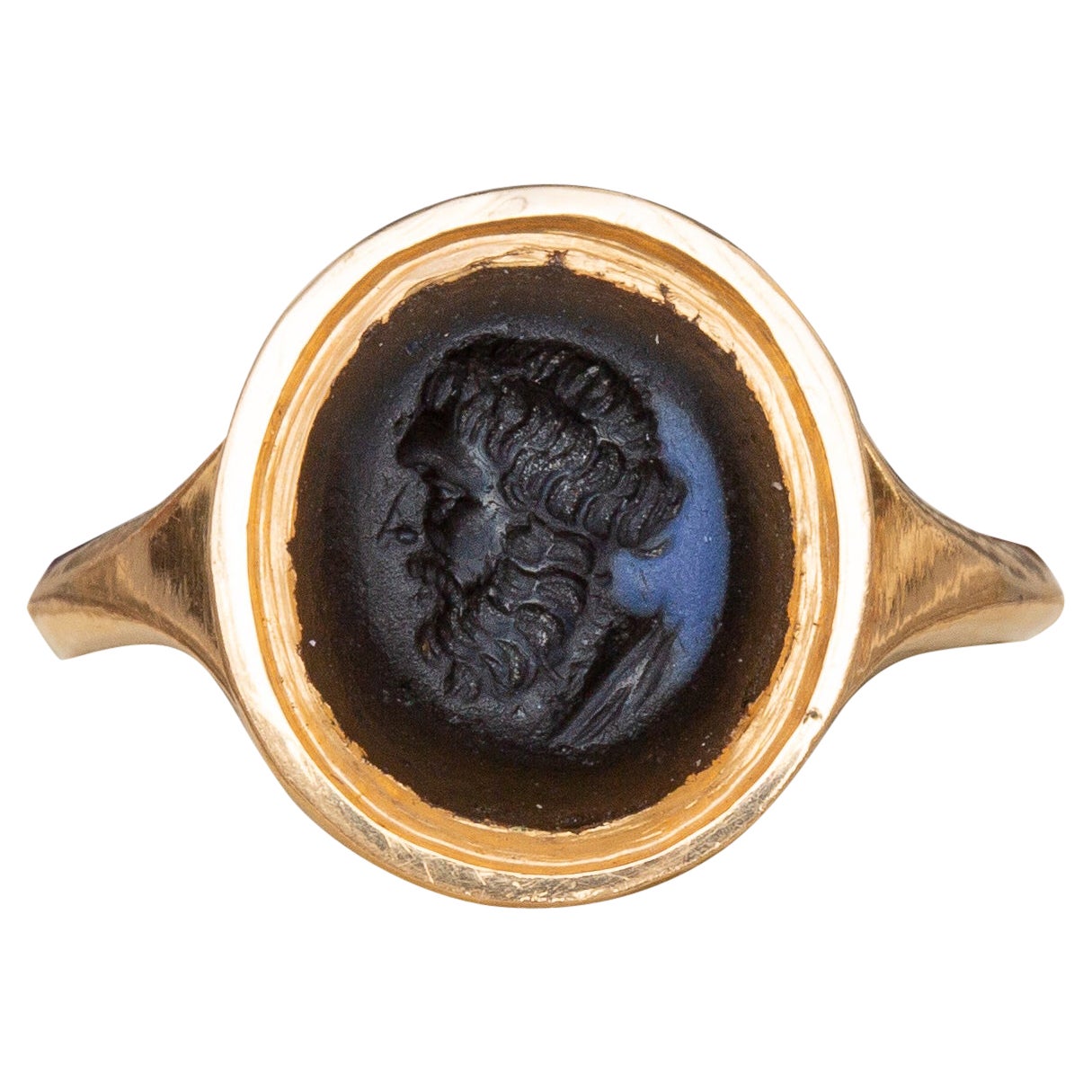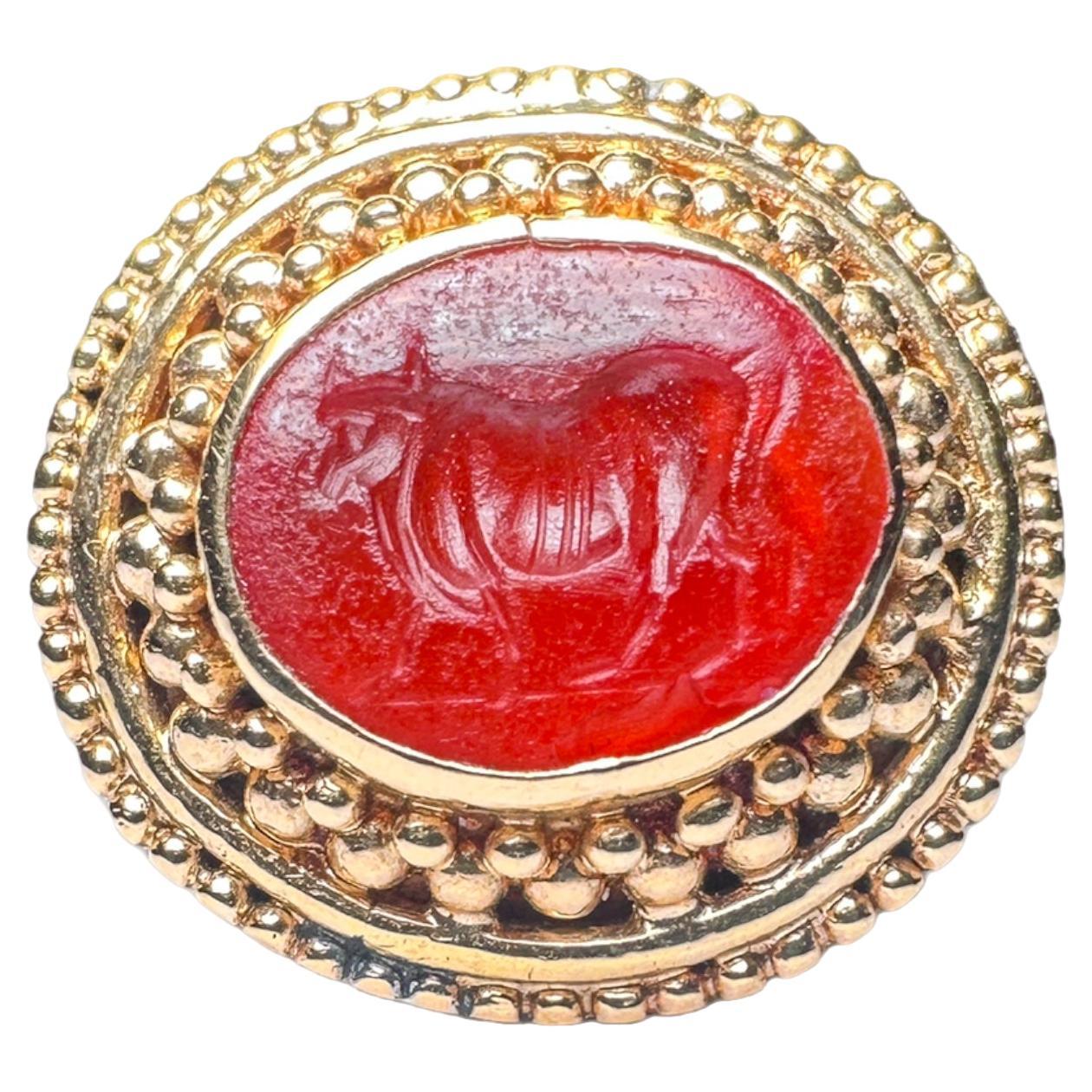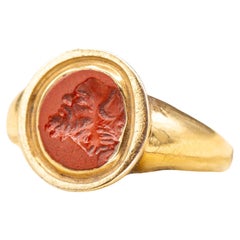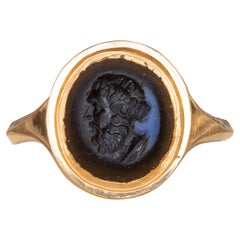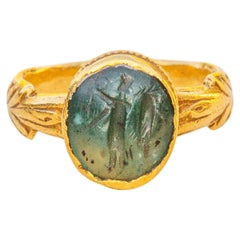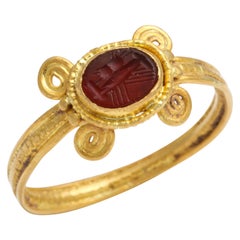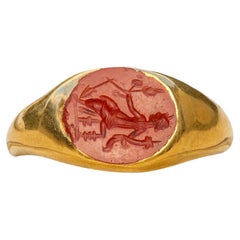
Small Ancient Roman Fortuna Intaglio Ring Engraved Jasper Antique Signet Ring
View Similar Items
Want more images or videos?
Request additional images or videos from the seller
1 of 17
Small Ancient Roman Fortuna Intaglio Ring Engraved Jasper Antique Signet Ring
About the Item
- Ring Size:3 US, Not Resizable
- Metal:
- Stone:
- Stone Cut:
- Style:
- Place of Origin:
- Period:
- Date of Manufacture:150
- Condition:Wear consistent with age and use.
- Seller Location:London, GB
- Reference Number:1stDibs: LU2845222127322
About the Seller
5.0
Vetted Seller
These experienced sellers undergo a comprehensive evaluation by our team of in-house experts.
Established in 2019
1stDibs seller since 2022
32 sales on 1stDibs
Typical response time: 11 hours
More From This SellerView All
- Ancient Roman Carved Red Jasper Gryllus Signet Ring Antique GeorgianLocated in London, GBAn ancient Romano-British carved jasper intaglio dating from the 2nd to 3rd century AD, set in a later gold mount dating from the late 18th century. The intaglio is intricately carve...Category
Antique 15th Century and Earlier Italian Georgian Signet Rings
MaterialsJasper
- Georgian 18th Century Signet Ring with Ancient Roman Nicolo Intaglio of HerculesLocated in London, GBA superb ancient Roman nicolo intaglio set in a late 18th century gold signet ring. Nicolo intaglios are a particular type of intaglio ma...Category
Antique Late 18th Century English Georgian Signet Rings
- Ancient Roman Green Chalcedony Plasma Intaglio Ring of Goddess Victoria NikeLocated in London, GBA scarce ancient Roman intaglio dating from the 1st to 2nd century AD, depicting Victoria, the Roman Goddess of Victory (also known as Nike in Greek mythology). The cabochon gemstone is a chromium chalcedony, mottled green in colour. It was known in the ancient world as a ‘plasma’ stone and was widely used in jewellery and seals throughout the Roman Empire. However the mineral disappeared from use in the ancient world towards the end of the 2nd century AD when the known deposits were mined out. The intricate ancient engraving depicts a winged Victoria, draped and facing left, holding a palm branch in her right hand and a laurel leaf in her left. The green gem is translucent and contains small dotted black natural inclusions. The gemstone’s viridian green tones were linked to nature, growth, and prosperity, reflecting the Romans' appreciation for abundance and fertility. Victoria played a major part of Roman society, with many temples erected in her honour including one on the Palatine Hill which would house the spoils of war from Roman victories. She was, to the Romans, a symbol of victory over death, ultimately determining who would be successful during war. The high number of artistic and architectural dedications to her bear witness to the popularity of the goddess’ cult: Victoria widely appears on Roman coins...Category
Antique 15th Century and Earlier Italian Classical Roman Signet Rings
MaterialsChalcedony, 22k Gold
- Antique 17th Century Engraved Silver Heraldic Coat of Arms Intaglio Signet RingLocated in London, GBThis rare heraldic silver intaglio signet ring dates from the late 17th century and originates from Western Europe. The flat, octagonal bezel is engraved with a noble family coat of arms depicting an eight pointed star. The silver ring is cast in one piece, the intaglio is framed within a chased octagonal border and the band displays flared and chamfered edges at the shoulders, all features typical of the period. After looking into heraldry archives, there are a few families in Western Europe which share this coat of arms, notably the Ambrogini family of Italy and the Counts of Waldeck, vassals of Luxembourg since the 14th century (see Ravensbury Antiques...Category
Antique Late 17th Century European Stuart Signet Rings
MaterialsSilver
- Important Antique Finnish 18K Coat of Arms Klinckowström Intaglio Signet RingLocated in London, GBA superb, scarce Finnish antique 18K gold ring that was made in Helsinki in the year 1854. The oval carnelian coat of arms intaglio is set in a large intricate gold repoussé work mount featuring scrolled foliate motifs. Incredibly, thanks to a full set of Finnish hallmarks, as well as from the intaglio carving itself, we can identify who commissioned and wore this superb seal ring. The coat of arms engraved into the carnelian gemstone is that of the Klinckowström family, an old Prussian noble house whose members played prominent roles in the history of Prussia, Sweden, Finland and Austria. The family was granted nobility in Sweden in 1684 by King Charles XI, and then received the rank of baron in 1759 from King Adolf Frederick. The baronial branch was listed in the Finnish House of Nobility (Ritarihuone) from 1818 until the family line ended in Finland in 1883. This baronial element can also be seen in the engraved coat of arms from the specific type of coronet used, it is set with pearls and known as a ‘Friherrlig rangkrona’, the coronet for Baron. The hallmarks tell us that this ring was made in Helsinki in the year 1854. Accordingly, the ring must have been made for a Baron (male) of the Klinckowström family, present and active in Finland during the mid-19th century. After researching into the genealogial records, only one member of the family settled in Finland, which was Baron Otto Wilhelm Klinkowström (1778-1850), and this ring would have been commissioned by his son Baron Arthur Wilhelm Wilhelmsson Klinckowström, shortly after his father’s passing. The ring would have been made in used to seal deeds and important letters in wax regarding family affairs. Arthur had two sons. Emil and Alexander who carried on the baronial title until 1883, when the family line ended on the male side. Although the time period of this ring also matches up with his both his sons, according to heraldry records they both carried a slightly different coat of arms. Arthur, the owner of this ring enrolled in the House of Knights in Finland aged 17 and soon after received the Order of St. John of Jerusalem. He spent the remainder of his years in various senior military positions, such as Lieutenant Colonel of the Finnish Sharpshooter Battalion and Colonel of the Kremenchugska Hunter Regiment. He passed away in 1860, not long after his father, which may explain why this ring is in such excellent condition with minimal signs of usage. His father, Baron Otto Wilhelm Klinkowström (1778-1850) was a Swedish lieutenant general who later moved to Finland, where he immediately found favour with Czar Alexander I of Russia...Category
Antique 1850s Finnish Victorian Signet Rings
Materials18k Gold
- Antique Gold Cameo Ring Greek Theatre Mask Silenus Hardstone Intaglio SignetLocated in London, GBA very unusual antique gold ring set with a carved brown and white hardstone cameo depicting the theatrical comic mask of Silenus, the Greek mythological old rustic god of wine-making and drunkenness. The ring was made in the late 19th century and carries French control marks for 18K gold, whilst the cameo is probably Italian and made slightly earlier, circa 1800. Silenus was a companion to the wine god Dionysus, and suitably he was a notorious consumer of wine, usually drunk and supported by satyrs or carried by a donkey. Silenus was described as the oldest, wisest and most drunken of the followers of Dionysus, and was said to possess special knowledge and the power of prophecy when intoxicated. He presides over the other satyrs and is related to musical creativity, prophetic ecstasy, drunken joy and drunken dances. Silenus was usually depicted as a jovial old man, bald yet bearded, with a pot-belly, thick lips and snub-nose. The masks worn to play him in theatre really emphasised these features, as you can see with this cameo carving Theatre was a key part of ancient Greek culture. The theatrical masks worn by the actors, known as ‘prosopon’, served various purposes. They enabled individual actors to play multiple roles (or genders) in the same performance; the exaggerated expressions helped define the character being portrayed; they helped spectators in the back rows to tell the characters apart. This particular masked as mentioned before is a comedic Silenus, please see final photo for other examples of Silenus masks in museum collections. UK size N 1/2, US size 7 4.84g 18K gold French ‘tête...Category
Antique Early 19th Century Italian Georgian Signet Rings
MaterialsAgate, 18k Gold
You May Also Like
- Antique Gold & Carved Carnelian Intaglio Signet Ring with an Ancient Roman HeroLocated in Philadelphia, PAA fine antique intaglio ring. Likely converted from an antique button or pin. In 14k gold With a carved carnelian cabochon depicting an unidentified Roman hero. Marked 14k to the...Category
20th Century Etruscan Revival Signet Rings
MaterialsCarnelian, Gold
- Ancient Roman First Century AD Red Jasper Intaglio of Apollo Men's RingLocated in Firenze, ITAncient Roman first century AD red jasper intaglio of Apollo in later 18kt carat yellow gold. Size 8 Long 2,3cm Weight:14,92gr.Category
Antique 15th Century and Earlier Italian Classical Roman Signet Rings
MaterialsJasper, 18k Gold, Yellow Gold
- Ancient Roman Carnelian Intaglio Ring with Clasped HandsLocated in Stamford, CTWe are proud to show this circular hoop of 22 Kt gold, with coiling around the shoulders, sets an oval shaped intaglio"dextrarum lunctio" on the carnelian. This translates to clasped...Category
Antique 15th Century and Earlier Italian Classical Roman Band Rings
MaterialsCarnelian, 22k Gold
- Ancient Roman Amethyst Intaglio Gold RingLocated in Chicago, ILRoman, circa 2nd – 1st centuries BC A museum quality, finely modeled, high carat (approximately 22.5K), hollow gold signet ring is set with an oval amethyst intaglio...Category
Antique 15th Century and Earlier Signet Rings
MaterialsAmethyst, Gold
- Ancient Roman Garnet Intaglio Gold RingLocated in Chicago, ILA museum quality ancient Roman gold ring, circa 400 AD. This hollow ring is bezel-set with a garnet intaglio of Hippocamp – a fish-tailed horse that w...Category
Antique 15th Century and Earlier Signet Rings
- Castellani Ancient Roman Agate Intaglio Gold RingBy CastellaniLocated in New York, NYCastellani® has selected this Ancient Roman Agate Intaglio for the "Cleopatra" Ring Setting. The intaglio dates to the 3rd to 7th Century. The intaglio is both black and white agate, which is a hard stone and very good for carving. The agate has two layers of color, black on the top and white at the bottom. The agate intaglio is solid and is one piece. The carver was able to use these two color layers to give dimension and detail. The Column and Angel on the left wings are white and the balance is all black. The Carver knew the material he/she was carving and used this to create this very unique scene. The intaglio shows two angels standing on either side of a column/pillar looking at the bust of a man on top of the pillar. The angels are female and male. The bust on the pedestal is of a male. The intaglio is set below the frame. The frame flairs out to a subtle point on the sides and has a flat surface. The "Cleopatra" ring design was a style that Castellani created in the 1860's and was inspired by Ancient Roman rings...Category
21st Century and Contemporary American Etruscan Revival Signet Rings
MaterialsAgate, 18k Gold, Gold
